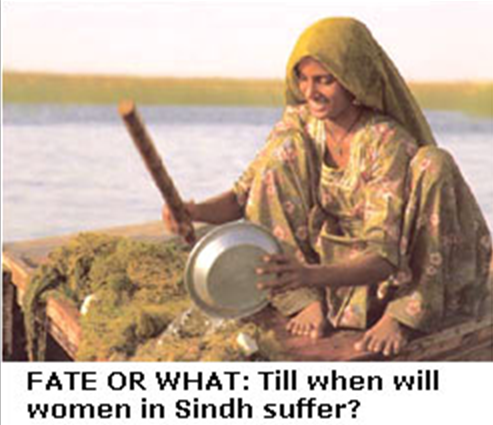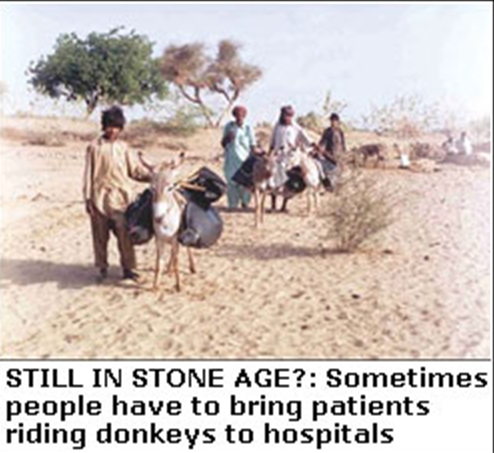Maternal mortality rate in Sindh
This is a collection of articles archived for the excellence of their content. Readers will be able to edit existing articles and post new articles directly |
Maternal mortality rate in Sindh
A dangerous situation
By Qurban Ali Khushik
The exceedingly high maternal mortality rate in Sindh is a major cause for concern
In rural Sindh, the problem of the infant mortality rate (IMR) and the maternal mortality rate (MMR) is assuming alarming proportions. The MMR in Sindh is highest in Pakistan, especially in areas such Kohistan, Kachho and Katcho. It needs to be mentioned here that 70 per cent of the population of these areas lives below the poverty line.
Since the people of the above-mentioned areas have to travel hundreds of miles from their homes to taluka/city hospitals, many pregnant women suffer miscarriages or die on their way to hospitals. Then there are those who pass away before even stepping out of their homes to reach any hospital because of the lack of health facilities in rural Sindh.
Dadu is one of the most backward and neglected districts of the province located between the Kheer Thar Mountain Range and the Indus River. There are 76 government hospitals in the region but only 31 of the Basic Health units (BHUs) and Health Centres (HCs) are functioning and that too without any budget being allocated for them. Hospital staff can only be found in the western belt of the district, Kachho. There is not a single gynecologist available at the District Head Quarter Civil Hospital and Dadu taluka hospitals of K.N. Shah, Mehar and Johi for the last many years because of which the IMR and MMR are increasing.
The Sita Road Government Health Centre was established in the region bearing in mind that it’s near the Katcho area, whereas there is a government hospital in Wahi Pandhi town, constructed because of its closeness to the Kheer Thar Mountain Range. Sadly, there is no gynecologist or other women staff available at these facilities to keep a check on the MMR or the IMR in the whole Katcho belt and nearby areas of Balochistan.
The K. N. Shah Taluka Hospital and Civil Hospital Dadu are considered to be two of the main hospitals in the Packo Area. They are supposed to take care of patients coming from all parts of the district. But even there the situation is not dissimilar as the hospitals are facing the shortage of skilled paramedical staff, women medical officers and qualified gynecologists. There is no neonatology unit in these facilities in order to protect the lives of the newborn in emergency.
The situation is particularly precarious at the Civil Hospital Dadu where a 30-bed ward is functioning without a gynecologist. The hospital administration admits that on occasions three women patients are asked to use just one bed.
On Dec 24, 2006, the 25-year-old Pathani Leghari, wife of Ghulam Hussain Leghari, resident of Manejo village Dadu Taluk was brought to Civil Hopsital on a donkey cart covering a distance of 10kms. Her condition had become serious because of a midwife who tried to help her deliver the baby after a fair amount of delay in the process caused by Pathani’s relatives. When she reached the hospital, woman medical officer Dr Zarina had to carry out an operation on Pathani, but her child had already died. According to Dr Zarina, Pathani had given birth to seven children, three of them had died at home during the delivery process, which were carried out by a local untrained midwife and one was a stillbirth. Pathani never received treatment from proper doctors during pregnancy.
A year ago, the health department of the government of Pakistan with the help US aid launched a five-year project, the Pakistan Initiative for Mothers and Newborns (PAIMAN) in 10 districts of the country. Two districts from Sindh -- Dadu and Sukur -- were selected as there the MMR is quite high. The Wahi Pandhi Government Hospital was selected as a model hospital whereas the Sita Road Hospital, the K. N. Shah Taluka Hospital and Civil Hospital Dadu were selected as main hospitals where the technical staff, machinery, and OT equipment were to be provided for controlling the MMR and the IMR.
The PAIMAN project has so far worked well. But its work can be best seen at the Sita Road Hospital. According to Dr Nabila Ali, within two months the Wahi Pandhi Hospital would also be renovated. A labour room and OT equipment along with one trained woman medical officer and other skilled paramedical staff would be provided to the facility soon.
After the Sita Road Hospital was given a face-lift, some 40 deliveries were carried out in 12 months. OT equipment was purchased and labour rooms at Civil Hospital Dadu and Taluka K. N. Shah Hospital were made. Forty midwives were given training at two health clinics at UCs Muradabad and Kamal Kamal Khan to take care of 30,000 people in the area with the help of an NGO. It is said that 70 per cent renovation work of the selected hospitals in Sukkur is complete. An MoU was signed with the Edhi Trust that all the trust’s centres would provide free services to patients for treatment at the PAIMAN selected hospitals in Dadu and Sukur districts.
Other areas of upper Sindh like Larkana, Shikarpur, Jaccobabad, Sukkur, Ghotaki, the Katcho belt, Khairpur, Naushehro Feroze, Nawab Shah, Hyderabad and western parts of the Indus River in the Jamshoro district also have a high MMR. All of them are facing shortages of gynecologists and trained lady health workers. According to the World Health Organisation (WHO), 150 million women become pregnant each year and 529,000 [0.529 million] die of pregnancy-related causes, while 62 million suffer morbidity and 99 per cent of deaths occur in developing countries.
In Pakistan over four million children are born every year, that is, eight babies are born every minute. It’s time the authorities concerned looked into the matter and made some more constructive efforts to fully counter the problem.

